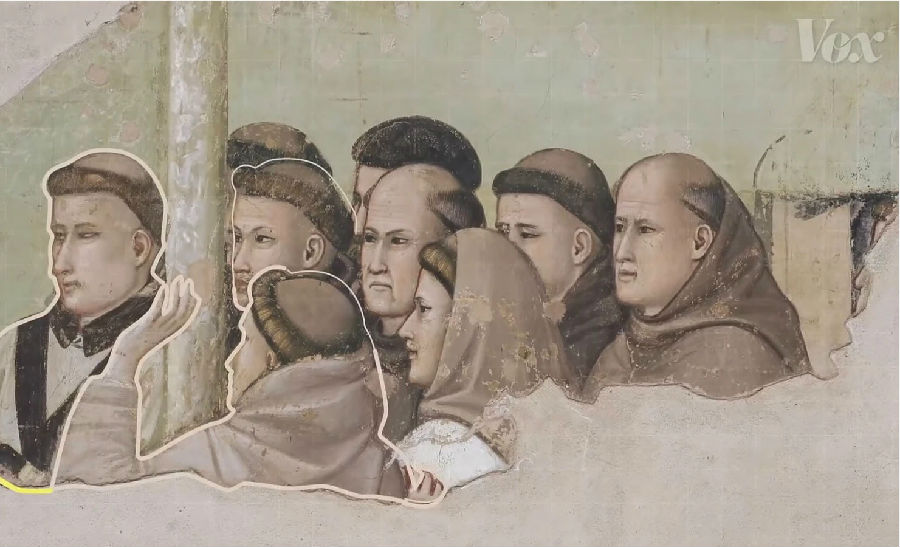(单词翻译:单击)
Look at this painting.
看这幅画。
It's Saint Francis and Pope Honorius III.
画上画的是圣弗朗西斯和教皇霍诺里厄斯三世。
You can probably find the monks.
大家或许会注意到画中的那些僧侣。
It's the hair.
因为他们留的发型。
This is not just a haircut.
但问题不仅仅是发型。
The more you look, the more this haircut shows deep religious divides.
观察得越仔细,你越会发现,这个发型还体现了深刻的宗教分歧。
One style was even lost to time, after being banned by the Roman Catholic Church.
有一种发型甚至还在被罗马天主教会禁止后消失在了时间的长河里。
The scalp is a statement of faith, but it's also a battleground.
暴露出来的头皮不仅是信仰的宣言,也是战场。
Hair's religious rite extends far beyond Christianity.
剃度这种宗教仪式远不止基督教有。
Some Buddhist monks shave their heads and some Orthodox Jews don't shave the corners of their heads.
一些佛教的僧侣会剃光头,某些正统的犹太人则会在剪头发时保留鬓角的头发。
The Catholic monks were known for centuries for their particularly distinctive hairstyle.
几个世纪以来,天主教僧侣一直以他们那种独特的发型闻名于世。
This haircut, with the center shave, is called a tonsure.
这种剃掉中间部分头发的做法叫做“削发礼仪”。
It started in the 4th or 5th century.
始于4~5世纪。
And the most recognizable is the Coronal tonsure, possibly modeled on Jesus' crown of thorns on the cross.
而最容易辨认的又数“冠状发式”,这种发型可能是为了模仿耶稣被钉在十字架上时戴的荆棘头冠。
It's actually one of three types.
这种发型是三种类似的发型之一。
The Coronal is the Roman, or Petrine tonsure, after Saint Peter.
“冠状发式”是罗马式削发,也叫“圣彼得削发”,是以圣彼得的名字命名的。
There's also the Pauline tonsure, named after Saint Paul, and used more commonly in Eastern Orthodoxy.
还有以圣保罗的名字命名的“圣保罗发式”,这种发式在东正教中更为常见。
It is a fully shaved head.
这是一种光头型发式。
But in the Dark Ages, there was a third tonsure too.
不过,在“黑暗时代”(即中世纪),还有第三种发式。
And that's the shape that largely disappeared from the Church.
不过这种发型很大程度上已经从教会里消失了。
That hairstyle was a visible symbol of diverging faiths and that's the reason that it was banned.
从这种发型的多种样式就能明显看出信仰的分裂,也正因为如此,它后来被禁止了。
When Pope Gregory sent missionaries from Rome to the British Isles in the late 6th century,
公元6世纪末,教皇格里高利从罗马派遣传教士到不列颠群岛时,
he found differences between the Roman Catholic Church and Celtic Church.
他发现了罗马天主教和凯尔特天主教之间的差异。
Ones that revealed serious disagreements about religious practice.
正是这些差异揭示了教徒们在宗教践行上出现了严重的分歧。
You live on the other side of the Atlantic,
你生活在大西洋的对岸你可能不知道,
but in these islands, the controversies that developed in the seventh century, they were very widespread.
但7世纪这些岛上曾发生过普遍的论战。
They covered both the south and the north of Britain and all of Ireland.
整个大不列颠和整个爱尔兰从南到北全部都加入了论战。
That brought the customs of the Roman Church up against the customs of the churches in Britain and in Ireland.
由此挑起了罗马教会和不列颠,爱尔兰教会的传统之间的冲突。
Celtic Catholicism was out of sync with the Roman Catholic Church.
凯尔特天主教没有和罗马天主教同步。
Roman Catholics would later use the differences between them
后来,罗马天主教徒就以他们之间的这些差异为由,
to portray Celtic Catholicism as Pagan or even as an offshoot celebrating the power-hungry magician, Simon Magus.
把凯尔特天主教徒说成是异教徒,甚至是崇拜权欲熏心的巫师“术士西满”的邪教分支。
There were concrete disputes.
这方面还出现了一些具体的争议。
Most importantly, they disagreed on when to celebrate Easter
其中,最重要的争议要数他们在庆祝复活节的时间上的分歧,
and another significant disagreement was the shape of the tonsure.
以及在发式形状上的分歧。
The Roman Church used a coronal or a "circular" tonsure.
罗马天主教会沿用的是“圆形”的冠状发式。
Churches in the British Isles used a different-shaped tonsure.
而大不列颠群岛的教会采用的则是另外一种形状的发式。
McCarthy wanted to learn the shape of this tonsure,
麦卡锡研究员想了解这个发式的形状,
because it represented the split in the Roman Celtic Churches.
因为它代表了罗马天主教会和凯尔特天主教会的分裂。
He thought the old guesses about its design were wrong.
他认为,以前人们对这种发式的形状的猜测并没有猜对。
You can't just scroll through photos of 7th century monk haircuts.
你不能只翻翻7世纪僧侣发式的照片就下结论。
Figuring out the shape of the tonsure these monks use, is a detective story.
因为弄清楚这些僧侣发式的形状的过程不亚于一场侦探之旅。
It required McCarthy to parse texts like the Book of Kells and records of old letters.
为此,麦卡锡仔细分析了《凯尔斯书》等文本和旧信件的相关记录。
From that, he could figure out the shape.
通过这些资料,他就能推断出这种发式的形状。
When it was viewed from the front, it superficially the Roman tonsure.
从前面看,这种发式和罗马式是一样的形状,
When it was viewed from the rear, it was cut straight between the ears.
但从后面看,又是从两个耳朵之间直接横着剪过去的形状。
These old texts and illustrations only gave McCarthy a view of the front and back of the head.
这些旧的文本和插图只能让麦卡锡了解到这种发型从前面看和从后面看的形状。
To picture an aerial view, he had to build one.
但要描绘从上往下看的形状,他还得自己推断。
It has to be a simple shape to be practically imposed on the human head. It has to be fairy simple.
首先,它必须是一个简单的形状,因为要方便在人脑袋上剃出那个形状,所以必须是个简单的形状。
I concluded that a triangle would be a possible solution.
所以我的结论是,答案可能是个三角形。
I had the good fortune that I had colleagues that were working in computer graphics--
幸运的是,我有几个从事计算机绘图工作的同事——
this was almost 18 years ago now that this was taking place.
不过那已经是差不多是18年前的事情了。
Things weren't quite as advanced as they are now.
那个时候技术还没有现在这么先进。
(But)They undertook to model these suggestions for me.
但他们还是帮我绘制了模型。
And they produced images from above looking down on the top of the head.
帮我出了从上往下看头顶时看到的形状。
And from behind.
从后面看的形状。
And then looking from the front at eye level.
以及沿着水平方面从前面看看到的形状。
These differences over tonsure were outward signs of a split in the Church.
总而言之,这些关于发式的分歧可以说是教会分裂的外在标志。
When the Roman Catholic Church took Ireland, they slowly changed its tonsure too.
当罗马天主教堂接管爱尔兰时,他们也慢慢地改变了爱尔兰天主教徒们的发式。
In 664, the king of Northumbria agreed on the Roman Catholic date for Easter and the Roman Catholic tonsure.
公元664年,诺森比亚国王同意了采纳罗马天主教的复活节日期和罗马天主教的发式。
The change wasn't instant, but over time the triangular tonsure disappeared.
虽然这种变化并非立竿见影,但随着时间的推移,三角型的发式就逐渐消失了。
Today some monks practice tonsure while others don't.
今天,部分僧侣还保持着传统的发式礼仪。
It varies across religion and monastery.
发式的形状也因宗教和修道院而异。
In the Roman Catholic Church, clerical tonsure ended in 1972.
在罗马天主教会,1972年后牧师就不再留传统发式了。
When it was common, this unusual haircut was a powerful symbol of monastic separation and the Church's power.
当这种不寻常的发式在当时还很常见的时候,它是修道院分离和教会权力的有力象征。
But it's actually not so strange.
但其实,这种发式在今天也并没有那么奇怪。
There is a fashion here for young men to completely shave the sides of their head and just leaving a patch on top.
我们这边的年轻人流行将两边剃很干净,只留头顶一撮头发。
Now, I don't believe there's any religious significance of this,
虽然我并不觉得他们留这种发型是出于宗教的缘故,
but you can see that there is a sort of a cult significance to them.
但我们可以看出,发型对人们还是有着崇拜意味的。
They're still ways in which we use to identify our membership of communities.
它们依然是我们用来表达群体属性的方式。
Now, I think that hair is particularly potent because it's visible all the time, and it's located right beside our control center.
在我看来,发型是我们表达身份属性的一种非常强有力的方式,因为你随时都能看到,而且它就位于我们的大脑上。
So it couldn't be in a hardly in a more significant location.
再没有比这个位置更合适的位置了。


